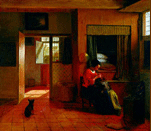










6.
Gender, Performance and National Identity:
Women and Seventeenth-Century European Theatre
Organizers:
Description:
Calling for discussion of women’s engagement with theatre in seventeenth-century
Europe, this workshop expands the definition of theatrical production and
of women’s involvement with theatre in the seventeenth-century. It moves
forwards from work on women’s dramatic writing and the English transvestite
boy actor to focus on the female performer, commissioner and patron herself
and the theoretical models used to analyse this work. The driving question
behind this session is what now for the history of women and early modern
theatre? Different performance genres, modes of female performance, and distinct
types of performer will all be covered alongside analysis of the literary
theatrical texts. In addition, the gendered and national identities of theatrical
cultures, the movement of female performers or patrons between nations and
the role of theatre and performance as a cultural interface will be vital.
One imperative is the interrogation of the current critical focus on English theatrical production. This may involve studies of theatre within the four nations of ‘Britain’, focusing either on individual women or theatrical cultures or working comparatively on the intersections between different national identities. In this way, the workshop answers to the concerns of the first plenary, ‘Geographies and Polities’. This shift of critical focus is also furthered through another main concern of this workshop: the consideration of women’s theatrical engagement within a European context. Again, this may take an individual or comparative form. One result of this, it is hoped, is that the prohibition of women from the English public stage will be rendered more explicable by reading English theatrical culture as part of European dramatic practice. For example, one particular group of women who may be considered in this way are the early modern queens consort. The movement of such women between the courts of Europe, and the cultural importations and intersections provided by their mobility demonstrate the part played by theatre in shaping gendered and national identity, and point to the ways in which the concerns of the first and second plenaries intersect within this workshop.
The theatrically engaged queen or queen consort, the cultural agency of the female elite of early modern Europe and their ability to shape theatrical production is one area of particular interest in the examination of degree, priority and place. Henrietta Maria, Marie de Médicis and Anna of Denmark are only a few examples of the women who might be discussed and indeed this workshop would encourage participants to look beyond these individuals. In the realm of elite theatrical commissioning and patronage, the commissioning of performance (e.g. command performances of particular plays or the commissioning of new works) and of theatrical venues and buildings will be considered. Applying the concept of the built environment to a tightly focused area, discussion is encouraged of the gendered spaces and architecture of early modern theatre. A further significant issue is the comparison of elite women’s theatrical production with that of non-elite women, such as the Italian and French commedia actresses and mountebanke performers, or the professional female actors of the ‘British’ Restoration. In so doing, the various ways in which women’s engagement with theatre was influenced by issues of gender, class, geography and national identity emerge.
This workshop will also ask its participants to consider issues of methodology in the exploration of early modern women’s theatrical engagement. How is this theorised by twenty-first century critics and do the models commonly used stand the test of time? One central issue might be the idea of agency: can the development of women’s involvement with theatre be ‘explained’ through agency or should we be looking for other ways of thinking through these materials? Other possibilities for interrogation include models of performance and gender theory, ideas of space, the voice, the body and movement, historicism and the role of the archive in research.
Such questions will form the basis of the workshop’s structure. Participants will be asked to compile a list of what they see as the most important issues to be addressed in the session, using the reading and a distributed set of questions as a potential focus. These ideas will then be brought to the workshop, and the ways in which they illuminate, challenge or replace the questions initially raised by the organisers will form the basis of our discussion. It is hoped, therefore, that the session will work out some broad templates for the discussion of women’s theatrical engagement.
Possible topics for discussion include:
Preliminary reading list.
Ben Jonson, The Masque of Queens, in Stephen Orgel and Roy Strong (eds), Inigo Jones and the Theatre of the Stuart Court (London: Sotheby Parke Bernet, 1973), I, pp. 131-53; or David Lindley (ed.), Court Masques: Jacobean and Caroline Entertainments (Oxford: Oxford University Press, 1995), pp. 35-53.
Aurelian Townshend, Tempe Restored in Inigo Jones and the Theatre of the Stuart Court, ed. by Stephen Orgel and Roy Strong (London: Sotheby Parke Bernet, 1973), II, pp. 479-504; or David Lindley (ed.), Court Masques: Jacobean and Caroline Entertainments (Oxford: Oxford University Press, 1995), pp. 155-65.
A collection of brief eye-witness accounts of female actresses’ visits to London and Chamberlain’s comments on Henrietta Maria and Anna of Denmark, to be compiled and distributed by the organisers.
It is intended that these texts will form a starting point for the consideration of English performing women within a European context, but the organisers would actively encourage participants who wish to focus on continental texts.
Additional suggested readings.
Ballet de Monseigneur le Duc de Vandosme, in Ballets et Mascarades de Cour de Henri II à Louis XIV, ed. by Paul Lacroix, Geneve, Chez J. Gay et fils, 1868, I, pp. 237-69.
Baltasar de Beaujoyeulx, Balet Comique de la Royne, ed. by Margaret McGowan (Binghamton, New York: Medieval and Renaissance Texts and Studies, 1985).
The Brackley sisters’ pastoral (to be transcribed from the Bodleian and distributed by the organisers).
William Davenant, The Rivals in The Dramatic Works of William D’Avenant, ed. by James Maidment and W. H. Logan (Edinburgh and London: H. Sotheran and Co, 1872), V, and The Wits in Maidment and Logan, II.
Italian commedia actress texts (to be distributed by organisers).
Mary Sidney, The Tragedy of Antonie, in Cerasano and Wynne-Davies, pp. 13-42; or Diane Purkiss (ed.), Three Tragedies by Renaissance Women (Harmondsworth: Penguin, 1998), pp. 37-95.
Richard White, Cupid’s Banishment in Renaissance Drama by Women: Texts and Documents ed. by S. P. Cerasano and Marion Wynne-Davies (London and New York: Routledge, 1996), pp. 76-90; or C. E. McGee, ‘Cupid’s Banishment: A Masque Presented to Her Majesty by Young Gentlewomen of the Ladies’ Hall, Deptford, May 4, 1617’, Renaissance Drama, new ser. 19 (1988), 226-64.
|
|
|
||||||
|
|
 |
 |
|
||||
 |
|
 |
|
||||
|
|
|
||||||
|
|
|
||||||
 |
|
||||||
|
|
|
||||||
| |
|
||||||
 |
|
||||||
 |
|
||||||
 |
|
||||||
 |
|
||||||
|
|
|
||||||
|
|
 |
|
|
||||
 |
|
||||||
|
|
|
|
|
|
|
|
|